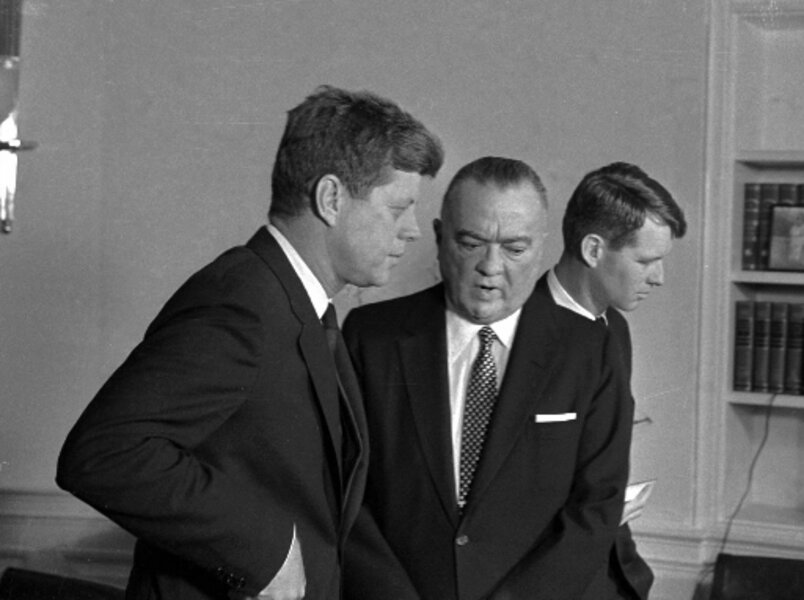Burglars who embarrassed FBI in unsolved document heist come forward
Loading...
On March 8, 1971, a group of burglars used a crowbar and a lock pick to slip into the FBI field office in Media, Pa. There, the group packed into suitcases what they had come for: papers containing untold, but expected to be embarrassing, secrets about the bureau’s domestic spying activities. The suitcases were then lugged to getaway cars.
The burglars never came forward, and they were never caught. It was an old-fashioned stealth crime – impressive if not in ingenuity, then in strategic prosaicness. In 1996, the Philadelphia Inquirer called it “the biggest unsolved burglary in American political history.”
But if the crime was quiet, its reverberations were loud. Out of the looted documents, which were mailed to reporters, unfolded years of newspaper articles tearing into the FBI's vast and clandestine surveillance programs under the tenure of its storied director, J. Edgar Hoover, as well as an even longer national meditation on the proper scope of government spying.
The theft also turned out to be heraldic of what was to happen almost 43 years later, when Edward Snowden, a burglar of the Digital Age, downloaded the National Security Agency documents that have since incited uproar over the reaches of US government surveillance. Now, in the midst of the Snowden uproar, and well past the expiration date of the statute of limitations on the 1971 criminal charges, five of the eight Media burglars have come forward, explaining the theft in a book by a reporter who was among the first to receive the stolen papers.
In "The Burglary: The Discovery of J. Edgar Hoover's Secret FBI," published Tuesday, author Betty Medsger explains the crime as the idea of William Davidon, a physics professor at Haverford College in Haverford, Pa., and an antiwar activist who said he had become frustrated with how little the simmering protests against the Vietnam War seemed to accomplish.
In 1971, Mr. Davidon assembled a group of antiwar activists and plotted a theft that the group hoped would have explosive consequences for the FBI, without exposing their own identities.
“None of us were into the martyrdom stuff,” John Raines, at the time a young professor of religion at Temple University and one of the burglars, told the Philadelphia Inquirer. “If we had not been pretty confident that we could get away with it, we wouldn't have done it.”
On March 8 – the same night that Muhammad Ali and Joe Frazier threw punches for the heavyweight championship of the world, a fabulous distraction on which the burglars were hoping to capitalize – the burglars approached the FBI office. They wore suits, ties, and gloves, NBC reported. And they knew just where to go. Bonnie Raines, Mr. Raines’s wife and a fellow burglar, had visited the office for weeks, posing as a college student inquiring about employment opportunities for women at the FBI. She understood the office’s security system.
The lone surprise was a new lock on the door the team had planned to jimmy, The New York Times reported. Keith Forsyth, at the time a young cabdriver and the designated lock-picker, got in through a different door.
On March 9, an anonymous caller who identified himself as from the previously unknown “Citizens Commission to Investigate the FBI” phoned a Reuters reporter to say that the group had “removed all the records,” Reuters reported at the time. Under that title, the group then mailed some 1,000 documents to select reporters.
The revelations came in dribs and drabs. Early on, the documents unveiled the existence of dozens of groups conducting surveillance on “left or liberal groups,” reported Ms. Medsger, then a reporter at The Washington Post and the first to publish an article on the papers. FBI surveillance had included tapping the Bell Telephone Co. to provide an alphabetical list of its subscribers – a close parallel to Snowden’s revelations, four decades later, about the NSA’s phone metadata collection program.
The leaked papers included, too, the first references to COINTELPRO, at the time a meaningless phrase to the reporters sifting through the documents. It was not until years later that reporters identified the term as referring to a secret program, carried out from 1966-71, to cultivate a culture of distrust in which dissidents feared not just the government, but also one another. Files had been opened on activists and reporters. Informants had been recruited in antiwar groups on college campuses, and spies had been deployed into African-American communities. A smear campaign had been levied against the Rev. Martin Luther King Jr.
Hoover canceled COINTELPRO, short for Counterintelligence Program, in 1972, and a 1976 Senate oversight report concluded that it had breached legal boundaries.
“A number of events during that era, including the burglary, contributed to changes in how the F.B.I identified and addressed domestic security threats," says Michael Kortan, an FBI spokesman, in a statement e-mailed to the Monitor.
The events led “to reform of the F.B.I’s intelligence policies and practices, including the creation of investigative guidelines by the Department of Justice,” Mr. Kortan writes.
Though hundreds of FBI agents were dispatched to catch the thieves, the case was closed with no solid leads on March 11, 1976, three days after the statute of limitations on the charges had expired. At the time the case was closed, the FBI had a sketch of Ms. Raines but had not found her, the Philadelphia Inquirer reported.
The group never told anyone what had happened on March 8, 1971, until one night, several years ago, when Mr. Raines over dinner revealed himself to Medsger as the person who had mailed her the packet of documents back in 1971, NPR reported.








